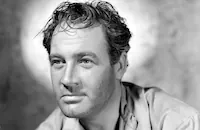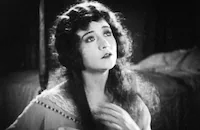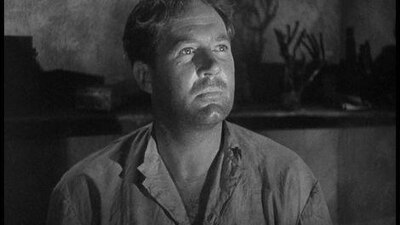Strange Cargo

Brief Synopsis
Cast & Crew
Frank Borzage
Joan Crawford
Clark Gable
Ian Hunter
Peter Lorre
Paul Lukas
Film Details
Technical Specs

Synopsis
At a penal colony in French Guiana, Verne, an incorrigible prisoner, makes an escape attempt but is turned in by Julie, a prostitute whom he accosts. Verne blackmails his way into another escape party led by Moll, a brutal killer who beats Verne in his sleep and leaves him behind. Cambreau, a benevolent, mysterious stranger who has recently appeared at the prison, leaves Verne a map of the escape route, however, and he follows, stopping en route to rescue Julie, who has been evicted from the colony and is being held at the mercy of Marfeu, her cruel captor. Julie and Verne join the escape party, which consists of Telez, a religious hypocrite; Hessler, a cynical bluebeard; Flaubert, a repulsive paranoiac; Dufond, a cowardly young man; Moll; and Cambreau, whose inexplicable foresight and wisdom saves the party again and again. As the convicts cross the jungle and leave the island in a boat, many of the party die, but are led to spiritual redemption by Cambreau at the moment of death. Only Verne, Julie, Hessler and Cambreau reach the mainland. Hessler, the only unrepentant convict, leaves the group while Julie, who has fallen in love with Verne, agrees to leave with the villainous M'sieu Pig, who covets her, to prevent him from reporting Verne. About to kill Cambreau to prevent him from talking, Verne realizes that Cambreau is God and repents, turning himself in. Julie, her sacrifice no longer necessary, agrees to wait for him.

Director

Frank Borzage
Cast

Joan Crawford

Clark Gable

Ian Hunter

Peter Lorre

Paul Lukas

Albert Dekker

J. Edward Bromberg

Eduardo Ciannelli

John Arledge
Frederic Worlock
Bernard Nedell
Victor Varconi

Paul Fix
Francis Mcdonald

Betty Compson

Charles Judels
Jack Mulhall
Dewey Robinson

Harry Cording
Richard Alexander
Bud Fine
James Pierce
Christian Frank
Mitchell Lewis
Dick Cramer

Ray Teal
Jack Adair
Hal Wynants
Art Miles
Bob O'connor
Eddie Foster
Gene Coogan
Frank Lackteen
Harry Semels
Art Dupuis
Stanley Andrews
William Edmunds
Crew
Frank Borzage
Lew Borzage
Daniel B. Cathcart
Jack Dawn
Cedric Gibbons
Lawrence Hazard
Robert J. Kern
Joseph L. Mankiewicz
Henry Noerdlinger
Robert Planck
Lesser Samuels
Douglas Shearer
Franz Waxman
Keith Weeks
Edwin B. Willis

Photo Collections
Videos
Movie Clip




Trailer
Hosted Intro
Film Details
Technical Specs

Articles
Strange Cargo (1940) - Strange Cargo
Based on a novel, Not Too Narrow, Not Too Deep (1936), by Richard Sale, Strange Cargo is, on the surface, the story of a group of hard-bitten convicts who escape from Devil's Island prison, and the prostitute who joins them on their journey. One of the men is a mysterious and intensely spiritual person who becomes a catalyst for the redemption of the others.
Crawford and Gable had been friends, frequent co-stars, and sometime-lovers for a decade. But they had not appeared in a film together in four years, and their relationship had grown strained over her refusal to co-star with him in Parnell (1937), a historical drama which had proved to be a disaster for Gable. Now, both were coming off hits. After Gone With the Wind (1939), Gable was the biggest star in the world. And following a series of mediocre films, Crawford had redeemed herself with a saucy performance as the home-wrecker in The Women (1939). So both were eager to re-team, and let bygones be bygones.
The production of Strange Cargo was uneventful, if at times uncomfortable. In contrast to her $40,000 Adrian wardrobe on The Women, Crawford's costumes on Strange Cargo -- three dresses bought off the rack at a chain store -- cost less than $40. In a scene where the stars ran through the jungle, they passed a snake in a tree. After shooting the scene once, Crawford realized that it was a live snake. Even though the snake's mouth had been secured shut with a rubber band, Crawford refused to do another take.
The real problems began after production ended. A month before Strange Cargo was released, Crawford realized that Gable's name would precede hers in the credits. Phone calls and memos to MGM executives from Crawford and her minions followed. Although the title credits were processed and prints of the film were about to be made, Crawford took her case to the top. MGM chief Louis B. Mayer was called in to make the decision. Back went the prints, and the film opened with the title card, "Joan Crawford and Clark Gable in Strange Cargo."
More problematic were the censorship issues Strange Cargo faced at every step. The Production Code office had refused to approve the initial script because it contained too much "illicit sex" and brutality. Once that was resolved, the Catholic Legion of Decency objected to the saintly character played by Ian Hunter. They felt that he was portrayed as a Christ figure, and that audiences would accept his pronouncements as the word of God. Because the character was key to the story, MGM refused to make changes. So Strange Cargo received a "condemned" rating from the Legion for presenting "a naturalistic concept of religion contrary to the teachings of Christ, irreverent use of Scripture, and lustful complications." The film was banned in Detroit, Boston and Providence, and picketed by Catholics elsewhere. Eventually, MGM agreed to make some minor changes, and the Legion of Decency reclassified the film as "unobjectionable for adults."
Reviews for Strange Cargo were mixed. There was praise for the performances, but some critics found the film's combination of high adventure and mysticism confusing. And the censorship controversy, along with Strange Cargo's downbeat, unusual subject matter, kept audiences away. Even the film's producer, Joseph L. Mankiewicz, would later say, "It was almost a good film. I wish it could have been made later. It was tough doing any kind of film that even approached reality in any way." But more than 60 years later, Strange Cargo remains one of the few films made by a major studio, at the height of the studio system, which is genuinely provocative and complex.
Director: Frank Borzage
Producer: Joseph L. Mankiewicz
Screenplay: Lawrence Hazard, Lesser Samuels, based on a novel by Richard Sale
Cinematography: Robert Planck
Editor: Robert J. Kern
Art Direction: Cedric Gibbons
Music: Franz Waxman
Principal Cast: Joan Crawford (Julie), Clark Gable (Andre), Ian Hunter (Cambreau), Peter Lorre (Cochon), Paul Lukas (Hessler), Albert Dekker (Moll), J. Edward Bromberg (Flaubert), Eduardo Ciannelli (Tellez).
BW-114m. Closed captioning.
by Margarita Landazuri

Strange Cargo (1940) - Strange Cargo
Strange Cargo - Joan Crawford and Clark Gable in the Offbeat 1940 Melodrama STRANGE CARGO on DVD
The script, based on a Richard Sale novel called Not Too Narrow...Not Too Deep, follows the escape of inmates from Devil's Island, the penal colony on French Guiana, in three distinct acts: in the colony and surrounding jungle, on an ocean voyage in a small sailboat, and finally on the mainland.
Religious allegory and symbolism are rampant. Before the prisoners plot their escape, a mysterious man named Cambreau (Ian Hunter, superb) wanders into the prison, posing as an inmate. He is calm and peaceful even as all the other characters argue and squabble amongst themselves. It's not long before we realize that Cambreau is meant to be God, especially in counterpoint to the inmate Hessler (Paul Lukas), who is essentially the Devil. The other inmates, including Gable, each have their own inner demons, and Crawford tags along as a tough saloon singer who is simply trying to get off the island. The ocean voyage acts as a sort of baptism for everyone, through which they start to undergo spiritual transformations thanks to Cambreau.
The characters debate issues of religion, philosophy, and the notion of good vs. evil throughout their journey, but this is not some heavy-handed, proselytizing "religious movie." Rather, the aforementioned themes are embedded in what is a Gable-Crawford melodrama with entertaining, hard-boiled dialogue, albeit one with especially thoughtful issues on its mind. A deglamorized Crawford delivers an excellent performance, and Gable is his usual man's-man self. Peter Lorre turns up as a character named "Monsieur Pig" (or just plain "Pig") who lusts after Crawford and is otherwise underused.
The biggest strength of Strange Cargo is that as the characters become aware of a spiritual world, the audience is made to feel something of the same. This is really the substance of the movie, since the plot per se doesn't amount to much. The characters - and their growing awareness of something beyond themselves - are had to get out of one's mind afterwards.
Director Frank Borzage uses visuals of darkness, fog, storminess, the ocean, and the jungle to lend a mysterious, otherworldly quality to the proceedings. Visually and thematically, it's his most mystical movie. In fact, while Strange Cargo is packaged in a new box set of Joan Crawford movies, it's really a Frank Borzage movie which happens to star Crawford. Borzage was a romantic idealist who made the most touching and beautiful love stories in the history of American cinema, coaxing performances out of Margaret Sullavan, Irene Dunne, Janet Gaynor and James Stewart that were among the best of their careers.
He is perhaps at the top of the list of great American directors whose films are wildly under-represented on DVD. Very few of his movies have been released, and of those that have, most are not among his really important works. Sadly missing on home video (as of 2008) are Borzage pictures like Street Angel (1928), Lucky Star (1929), After Tomorrow (1932), Man's Castle (1933), Little Man, What Now? (1934), No Greater Glory (1934), Desire (1936), History is Made at Night (1937), Three Comrades (1938), The Mortal Storm (1940), and Moonrise (1948). All are worth seeking out whenever one gets the chance.
There is an ethereal beauty to his best movies, both in their physical lighting and in the emotions that Borzage pulls out of the story and performances. Often in his films there is a primary romantic couple whose struggle of some sort isolates them, thereby concentrating their experience and feelings to an intense degree not often depicted on screen. Strange Cargo is something of an anomaly for Borzage. It has the spirituality of his other films - taken to the limit with a character who is essentially a living Jesus Christ - and it has Clark Gable and Joan Crawford as a couple, but it is not primarily a romance picture. Instead of a couple being isolated from the world, here a group is isolated. Instead of love between two people intensified, here everyone's own individual sense of spirituality is heightened. It's both totally different and quite similar to his other movies.
Strange Cargo is included in Warner Home Video's Joan Crawford Collection Volume 2. Image quality varies, with the interiors generally looking sharper; mostly, though, it looks great. Among the extras is an excellent 14-minute featurette on Gable and Crawford produced by Peter Fitzgerald. Both stars came from rough childhoods. As film historian Jeanine Basinger explains, "They were tough human beings who were uneducated, from small towns with bad backgrounds, and that's partly why people loved them, because they reached out and touched real people. They seemed real, but grander than real." Gable and Crawford had amazing screen chemistry which carried on into a real-life affair that was on-and-off-again for many years, as each entered into other marriages. They were among the top 10 box-office stars through most of the 1930s, though by decade's end Crawford was considered box-office poison. Other talking heads in this featurette include Molly Haskell, Richard Barrios, and Crawford's daughter. Very well-chosen clips and stills add appropriate context.
Other extras include a short subject, More About Nostradamus, a so-so MGM cartoon, The Lonesome Stranger, and a trailer. Elsewhere in the box set are Sadie McKee (1934), A Woman's Face (1941), Flamingo Road (1949) and the camp classic Torch Song (1953). All have various extras including cartoons, shorts, radio adaptations, recording sessions, and two additional new featurettes featuring the same film historians as on the Strange Cargo disc. The DVDs come in an attractive fold-out package with brief liner notes. This "fold-out" packaging seems to be a new thing for Warner Home Video. Most collectors prefer individual slim cases for each title; perhaps this is Warner's way of trying to prevent reselling. In any event, this is another terrific box set from the studio and well worth a look.
For more information about Strange Cargo, visit Warner Video. To order Strange Cargo (which is available only as The Joan Crawford Collection, Volume 2), go to TCM Shopping.
by Jeremy Arnold
Strange Cargo - Joan Crawford and Clark Gable in the Offbeat 1940 Melodrama STRANGE CARGO on DVD
Quotes
Don't go tapping on your heart, you'll break your fingers.- Julie
Trivia
Joan Crawford's wardrobe consists of three ready-to-wear dresses which cost under $40.
Received a condemned rating from the Legion of Decency for "irreverent use of Scripture" and "lustful complications." Even after the studio made the changes demanded, distribution was sharply cut by cities refusing to book it.
Joan Crawford and Clark Gable shot a scene where they are running through the marshlands. At one point, they pass a snake hanging in a tree. After they shot the scene once, Joan suddenly realized that the snake was real. "That son-of-a-b**th is alive!". When informed that the snake's mouth had been tied shut with a rubberband, she said "And what happens if the f**king rubberband snaps!" and refused to shoot the scene again.
Notes
A working title for this film was Not Too Narrow, Not Too Deep. The picture was the last of eight films co-starring Clark Gable and Joan Crawford. According to the file for the film in the MPAA/PCA Collection at the AMPAS Library, in October 1939, the PCA urged M-G-M not to show scenes of illicit sex, the "reading of the Bible with sarcasm" and the throwing away of the Bible. A March 1940 New York Times news item notes that the Legion of Decency placed the film in the "condemned" category and protested the film's "anaturalistic concept of religion contrary to the teachings of Christ and the Catholic church." A Hollywood Reporter news item indicates that Strange Cargo was banned in Detroit. In England, censors deleted the scene in which the convict discusses the Bible and identifies himself with God. Modern sources indicate that the film was also banned in Boston and Providence, RI. Some filming took place in Pico and Laguna, CA. A biography of producer Joseph L. Mankiewicz quotes him as saying: "It was almost a good film. I wish it could have been made later. It was tough doing any kind of film that even approached reality in any way." According to modern sources, some retakes were shot in mid-January 1940.

Miscellaneous Notes
Released in United States 1940
Released in United States 1940















